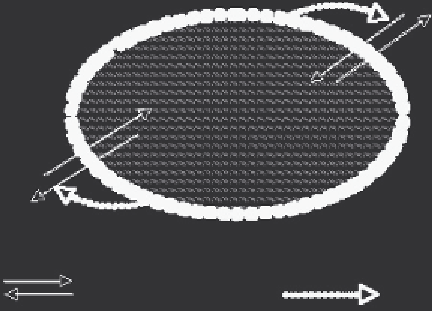Biology Reference
In-Depth Information
ENVIRONMENT
SYSTEM
Physico-chemical
interactions
Functional
action
Figure 1
Agency in a basic autonomous system
will constitute a functional loop of the system itself, i.e., agency constitutes
an environmentally mediated process, but clearly asymmetric.
18
The interactive
processes are driven by the internal organization of the system. An example of a
very basic form of agency (universally present in all cellular life) is the mecha-
nism of active transport, which is an in/out flow of matter against a concentration
gradient driven by a free energy source.
19
Agency involves a functional action
on the environment, modifying (and later controlling) certain environmental
conditions for the system's dynamics. In short, seen from a thermodynamic per-
spective, autonomy is the necessary expression of nontrivial self-maintenance.
Without autonomy, either the organization of a system is extremely simple or,
if complex, it is dependent on another more complex one (whose origin requires
explanation).
Let us summarize. Starting from simple dissipative chemical organizations,
with maintenance highly dependent on a set of specific external conditions, a
process of exploration of new organizational forms and retention of the functional
ones leads to progressively more complex organizations. As this process takes
place in a chemical scenario, the increase in complexity of the systems creates
an accumulative process of construction of bigger, more complex components,
which in turn are the necessary elements for the creation of more complex
organizations.
The progress occurs when certain specific form of the former collateral
complexity is recruited. Thus, in every step, the new organization achieves SM
18
Asymmetric in the sense that the environment cannot establish such recursive interaction processes with the
agent, unless we are speaking of an interactive coupling between two agents.
19
This mechanism must have appeared in early forms of cellular organizations because it is required for
avoiding an osmotic crisis, which would lead to the bursting of the cell.

